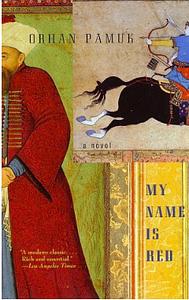Take a photo of a barcode or cover
This is objectively a very complex and well written novel. Pamuk’s reliance on the unreliable narrator trope is actually quite effective, and his talent as a writer shines as he takes on the challenge of developing 10ish distinct voices in one story. I feel like I would’ve gotten more out of this novel, had I 1. had a more intimate understanding of Islam and 2. not been so put off by the heavy philosophical themes. I am not someone who is intrigued by the deep reflection on humankind and history that Pamuk explores in this work, but I am sure that it is interesting to a great deal of people. I was frustrated by the lackluster of the reveal of the murderer: Olive was the most boring and least discussed miniaturist out of the 3 from the workshop who were still alive. I knew it was Olive quite early on, and while I can see that the main intention of the novel is not the murder mystery aspect, I was still disappointed by how simple it was to tell that Olive killed Enishte Effendi and Elegant Effendi. The voice from the “I Will Be Called a Murderer” chapter said himself that he tried to make this alter ego of his completely different from his true self, so to me, the cunning and evil voice of the murderer was the exact opposite of the docile and traditional nature of Olive.
After awhile, I felt like it got repetitive with the philosophical ideologies that were discussed. Illustration is both an affront and a tribute to Islam; portraiture is blasphemy and daring originality; sex win both men and women is an expression of both power and passion; blindness is the ultimate vision of success in God’s eyes... the paradoxes were interesting, but predictable after a couple hundred pages.
The other (and admittedly less significant) thing with this novel is that it was quite slow for my taste. I almost put it down just because there were a couple of times where I really had to force myself to power through the Dickensian descriptions of nearly everything the novel addresses. However, the history of Istanbul and Turkey was fascinating to me. I would give one of Pamuk’s more recent, contemporary-set novels a shot before I write him off for good. He is a talented writer—it just so happens that the novel of his that I picked up is not my cup of tea.
After awhile, I felt like it got repetitive with the philosophical ideologies that were discussed. Illustration is both an affront and a tribute to Islam; portraiture is blasphemy and daring originality; sex win both men and women is an expression of both power and passion; blindness is the ultimate vision of success in God’s eyes... the paradoxes were interesting, but predictable after a couple hundred pages.
The other (and admittedly less significant) thing with this novel is that it was quite slow for my taste. I almost put it down just because there were a couple of times where I really had to force myself to power through the Dickensian descriptions of nearly everything the novel addresses. However, the history of Istanbul and Turkey was fascinating to me. I would give one of Pamuk’s more recent, contemporary-set novels a shot before I write him off for good. He is a talented writer—it just so happens that the novel of his that I picked up is not my cup of tea.
DNF p54: not vibing it personally. Too many ruffles, too little plot/character.
slow-paced
Plot or Character Driven:
A mix
Strong character development:
Yes
Loveable characters:
No
Diverse cast of characters:
No
slow-paced
Plot or Character Driven:
A mix
Strong character development:
No
Loveable characters:
No
Diverse cast of characters:
No
Flaws of characters a main focus:
Complicated
challenging
reflective
medium-paced
Read it faster than I thought I would but really had to force myself through parts. Really duplicitous characters, certainly wasn’t rooting for anyone. Interesting view into 16th century Ottoman art world, glad I read it and yet also was glad to be done bc I couldn’t figure out who the murderer was and the characters were all so unpleasant and exhausting
dark
emotional
mysterious
reflective
sad
tense
slow-paced
Plot or Character Driven:
Plot
Strong character development:
Yes
Loveable characters:
Complicated
Diverse cast of characters:
Yes
Flaws of characters a main focus:
Yes
This is, as far as I can remember, a beautiful book with a fascinating story.
A wildly interesting, complex book, “My Name is Red” is multiple things wrapped into a murder mystery. Part philosophical treatise on art, part historical narrative, part love story and all interesting. A review of this book could go on and on, but what is most fascinating to me was the way the author effortlessly changes narrators from chapter to chapter, but never losing the plot or over complicating it. Touching on theology, history, and myth, it actually, at one point, tells a chapter from the point of view from the color red. It works. But the flaw for me was that at times, it digressed too far into art theory and downright bloviation later in the book. When things are getting really interesting, the reader is forced to wade through a tertiary characters ramblings about art nobody can see, and it gets tiresome. At nearly 700 pages, there were easily 100 pages or so of rambling that could have been lifted without story or musing vibe suffering the loss.
Ultimately my life is richer for having read this book, but sadly my interest in it began to fail with about 150 pages to go, and it limped to the end. When the murderer is revealed and multiple plot lines resolved, it all felt as if it were an afterthought and needlessly strung out. A shame because otherwise this is an incredible novel.
Ultimately my life is richer for having read this book, but sadly my interest in it began to fail with about 150 pages to go, and it limped to the end. When the murderer is revealed and multiple plot lines resolved, it all felt as if it were an afterthought and needlessly strung out. A shame because otherwise this is an incredible novel.
emotional
informative
mysterious
reflective
slow-paced
IMO this is one of those books that you read because it’s supposed to be brilliant, and as you’re reading you note to yourself the occasional bit of brilliance, but in all honesty you’re kind of relieved when it’s over.
At one point, a person asks a fairly straightforward question and receives the response: “Let me answer with a parable.” and I think that tells you all you need to know about this book.
At one point, a person asks a fairly straightforward question and receives the response: “Let me answer with a parable.” and I think that tells you all you need to know about this book.




